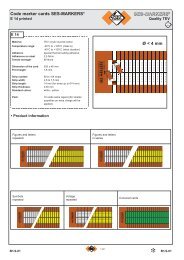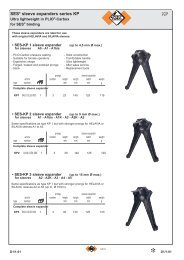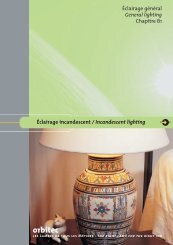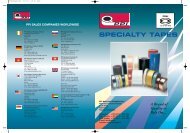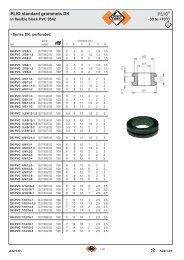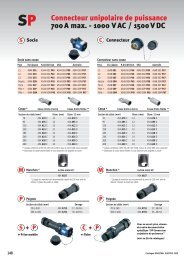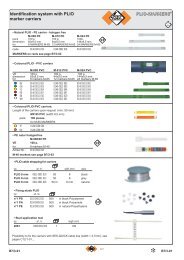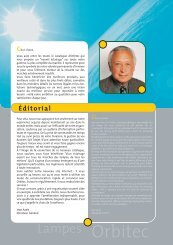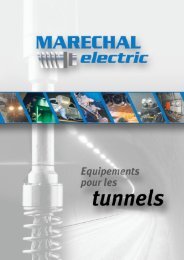Kapton Data Sheet - Professional Plastics
Kapton Data Sheet - Professional Plastics
Kapton Data Sheet - Professional Plastics
Create successful ePaper yourself
Turn your PDF publications into a flip-book with our unique Google optimized e-Paper software.
Radiation Resistance<br />
Because of its excellent radiation resistance,<br />
<strong>Kapton</strong> ® is frequently used in high radiation<br />
environments where a flexible insulating<br />
material is required. In outer space, <strong>Kapton</strong> ® is<br />
used both alone and in combination with other<br />
materials for applications that require radiation<br />
resistance at minimum weight. U.S. Government<br />
laboratory test data on gamma and<br />
neutron radiation exposure of <strong>Kapton</strong> ® are<br />
summarized in Tables 12 and 13.<br />
Testing the suitability of <strong>Kapton</strong> ® for nuclear<br />
reactors and linear accelerators involves<br />
exposure to an adverse chemical environment<br />
in addition to radiation. For example, loss of<br />
coolant accident (LOCA) tests for qualification<br />
in containment areas in nuclear power plants<br />
expose the system to steam and sodium hydroxide,<br />
both of which tend to degrade <strong>Kapton</strong> ® .<br />
Accordingly, when <strong>Kapton</strong> ® is used in nuclear<br />
power systems that require certification to<br />
IEEE-323 and -383, engineered designs that<br />
protect <strong>Kapton</strong> ® from direct exposure to LOCA<br />
sprays are required.<br />
The excellent ultraviolet resistance of <strong>Kapton</strong> ®<br />
in the high vacuum of outer space is demonstrated<br />
by the data in Table 14. In the earth’s<br />
atmosphere, however, there is a synergistic<br />
effect upon <strong>Kapton</strong> ® if it is directly exposed to<br />
some combinations of ultraviolet radiation,<br />
oxygen, and water. Figure 23 shows this effect<br />
as a loss of elongation when <strong>Kapton</strong> ® was<br />
exposed in Florida test panels. Figure 24 shows<br />
the loss of elongation as a function of exposure<br />
time in an Atlas Weatherometer. Design considerations<br />
should recognize this phenomenon.<br />
Table 12<br />
Effect of Gamma Radiation Exposure on <strong>Kapton</strong> ® Polyimide Film<br />
(Cobalt 60 Source, Oak Ridge)<br />
Control 10 4 Gy 10 5 Gy 10 6 Gy 10 7 Gy<br />
Property 1 mil Film 1 h 10 h 4 d 42 d<br />
Tensile Strength,<br />
MPa 207 207 214 214 152<br />
psi × 10 3 (30) (30) (31) (31) (22)<br />
Elongation, % 80 78 78 79 42<br />
Tensile Modulus,<br />
MPa 3172 3275 3378 3275 2903<br />
(psi × 10 3 ) (460) (475) (490) (475) (421)<br />
Volume Resistivity 4.8 6.6 5.2 1.7 1.6<br />
Ω⋅cm × 10 13 at 200°C (392°F)<br />
Dielectric Constant 3.46 3.54 3.63 3.71 3.50<br />
1 kHz at 23°C (73°F)<br />
Dissipation Factor 0.0020 0.0023 0.0024 0.0037 0.0029<br />
1 kHz at 23°C (73°F)<br />
Dielectric Strength 256 223 218 221 254<br />
V/µm (kV/mm)<br />
Table 13<br />
Effect of Electron Exposure on <strong>Kapton</strong> ® Polyimide Film Mixed<br />
Neutron and Gamma<br />
5 × 10 7 Gy 10 8 Gy<br />
5 × 10 12 neutrons/cm/s Film Darkened Film Darkened<br />
Flux at 175°C (347°F)<br />
and Tough<br />
20



